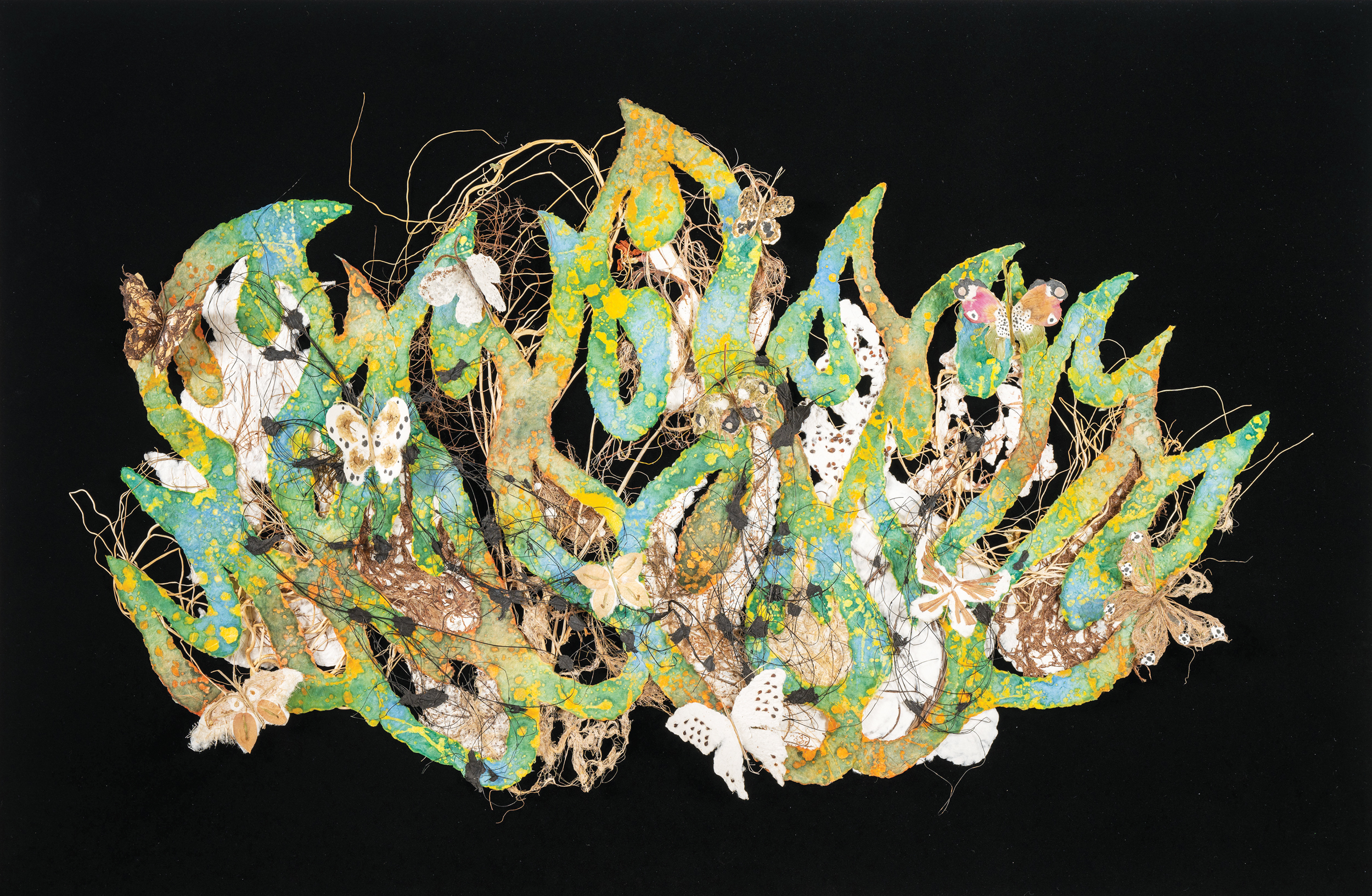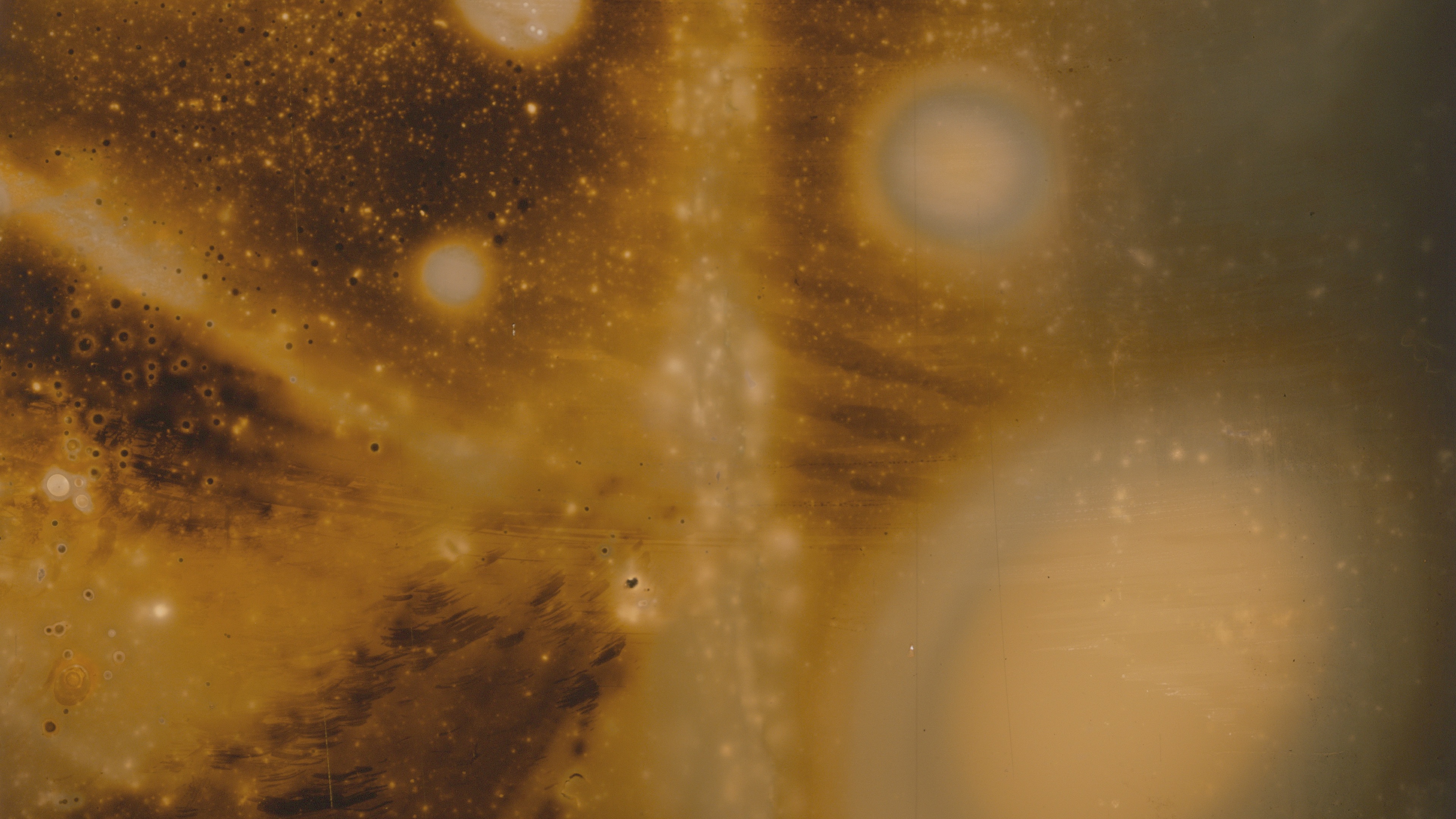Hong Kong: Listening Through Imagery: Interview with Enzo Camacho and Ami Lien
By HG Masters

ENZO CAMACHO and AMI LIEN’s Langit Lupa, 2023, still from digital video and 16mm film: 56 min 21 sec. Courtesy the artists and 47 Canal, New York.
Enzo Camacho and Ami Lien opened their exhibition “Offerings for Escalante” at the Hong Kong nonprofit space Para Site in late October. Featuring handmade paper works and a 16mm stop-motion animation, the exhibition centered around a new film Langit Lupa (2023) that they shot on a sugarcane-plantation in the Philippines island of Negros, where paramilitary forces had massacred at least 20 protesters on September 20, 1985, in the small city of Escalante. While in Hong Kong, Camacho and Lien also organized workshops and a fundraiser for SAKA and MARTYR to bring together labor-activist networks in the Philippines and abroad.

Portrait of (left to right) AMI LIEN and ENZO CAMACHO. Photo by Piotr Niepsuj.
What is “critical listening” and how did you practice it in addressing the Escalante Massacre in your experimental documentary Langit Lupa?
AMI LIEN: The term came out of a conversation we had with Eunsong Kim, who wrote the essay “On Heaven, Earth, Hell” about our film. She was interested in how we sourced the survivor testimonials, which incrementally build up to an account of the events of the Escalante Massacre from the perspectives of the protesters. This narrative format challenges what audiences usually expect from documentaries, which tend to tell the story from the perspective of the documentarian. We initially prepared specific questions, but we didn’t necessarily end up asking them. In the process of conducting the interviews, we recognized how clearly our interviewees wanted to share their experiences through their own culture of narration. “Critical listening” involved making space for that.
ENZO CAMACHO: We tried to allow the survivors to craft their own narratives. We also tried to integrate this kind of critical listening into the form of the film itself, to “give space” through our editing choices and to create the right conditions for absorbing these stories through deliberate pacing or the use of certain visuals. In a way, we wanted to allow the viewers to listen through the imagery.
How did you approach the obligations of documentation around this traumatic event?
EC: We have been conducting research on Negros island since 2017, and we wanted to address the overall situation of political violence there, which continues up until the present. The story of the 1985 Escalante Massacre was one of many stories we could have told, but it was one that we found particularly resonant, given the rampant historical revisionism that has been happening in the Philippines with regards to the Marcos dictatorship era. Because of this, there is a very real political urgency to the act of documenting. We began with the survivors’ testimonies and then made choices about what to show and what not to show in the film. We decided against revealing the faces of the interviewees and against using archival footage, for example. We were careful not to overdramatize, but to simply try to create an appropriate container to hold these narratives and allow them to resonate in the present. Beyond these formal questions, we have also been thinking a lot about how we can use the film’s presentation as opportunities to provide continued support to the survivors and the political struggle that they are aligned with, which is a primary obligation for us.
AL: In that sense, we had to weigh our priorities between the work itself and a sense of responsibility to the broader social movement against dictatorship in the Philippines. We began to reorganize our practice according to these priorities, to observe how they could embody deep contradictions, on the one hand, or be mutually affirming on the other. While our artwork does not have to resolve political problems, it can enable things to occur outside of our practice, through building relationships and real possibilities for political education, including with the many children and their families whom we worked with.

ENZO CAMACHO and AMI LIEN, Flame Garden (spring), 2023, mixed media, 119 × 76 cm. Courtesy the artists and 47 Canal, New York.
How did children end up at the heart of Langit Lupa and the works made from handmade paper?
AL: When we returned to Negros after the pandemic, the political situation in the Philippines was quite tense. Being aware of our position as outsiders to the political conflict on the island, we decided to immerse ourselves in a community quite close to Escalante. We rented a house in a small, coastal village, where neighborhood children began to come over to play with us and make art together. It was a beautiful process of learning from one another, and gaining trust from members of the community, including some the children’s grandparents who eventually shared that they had helped organize the peoples’ strike that had ended with the massacre. Considering these close connections, we felt that the children embodied the legacy of the massacre while also being a source of hope.
EC: We also continued our paper-making practice during our time there using local plant materials, which was a way for us to learn more about the natural landscape of Negros and about how folks relate to it culturally. This practice had an important social component as well, in that we were conducting paper-making workshops with the children of the community. Similar to the film, we see our handmade paper works as being very much the product of social relations and processes.
%201.jpeg)
Langit Lupa, 2023, still from digital video and 16mm film: 56 min 21 sec. Courtesy the artists and 47 Canal, New York.
%202.jpeg)
Langit Lupa, 2023, still from digital video and 16mm film: 56 min 21 sec. Courtesy the artists and 47 Canal, New York.
What role does the use of natural materials—including leaves bitten by insects—as “phytograms” and forms of abstraction play in Langit Lupa?
AL: We are influenced by both experimental film and psychedelia, but we wanted to explore the physicality of the filmic experience, in order to create these alternative conditions for receiving knowledge. In doing so, we also wanted that knowledge to be a motivating stimulus for action, while again allowing a certain kind of space for the information to slip into the mind.
EC: The use of the phytograms also builds connections between the political and environmental narratives that we explore in the film. The plants function as another kind of “witness” to the history we are trying to address.
How can art become accountable to social movements? Or how does your practice attempt to do that?
AL: I sometimes notice that even the most political documentaries can replicate forms of extraction; we are enmeshed in capitalist structures, from the plantation to the cultural industries, which transform materials into commodities through exploitative processes. To counter that, you cannot assume the artwork does enough. I think it’s been really important for us to be sensitive to the material aspect of the social relationships generated by cultural work. We began to re-examine our art practice and the institutions we work with as resources, in ways that are not singularly focused on producing exhibitions.

Activists and musicians from the Philippines connecting with Hong Kong domestic workers and other activists in Hong Kong on November 5, 2023. Photo courtesy the artists and Para Site, Hong Kong.
What are your reflections on your Hong Kong paper-making workshop, the mutual-aid fundraiser for SAKA and MARTYR, and the Chater Road events?
EC: When we conducted the first interviews, the survivors shared a past experience in which researchers had interviewed them for a book, but then didn’t follow up with them afterwards or offer any further support. We wanted to make sure that we could sustain these relationships long after production. For the exhibition in Hong Kong, we were in conversation with various political organizations in the Philippines and Hong Kong for several months. They gave us feedback on our proposals, which defined how we developed the programming. The main concern was to make sure that the exhibition could actually be useful for these organizations and their work.
AL: Similarly, the workshop with residents from Bethune House, a shelter for migrant laborers facing legal cases, became a powerful group conversation. The workshop was led by a volunteer at Bethune, who to our surprise gave an incredible introduction to our exhibition, speaking about the agrarian struggle with such intensity and passion! Watching the Filipino participants feel connected to their homeland through our workshop also generated conversations on remembrance and loss that were incredibly moving.








